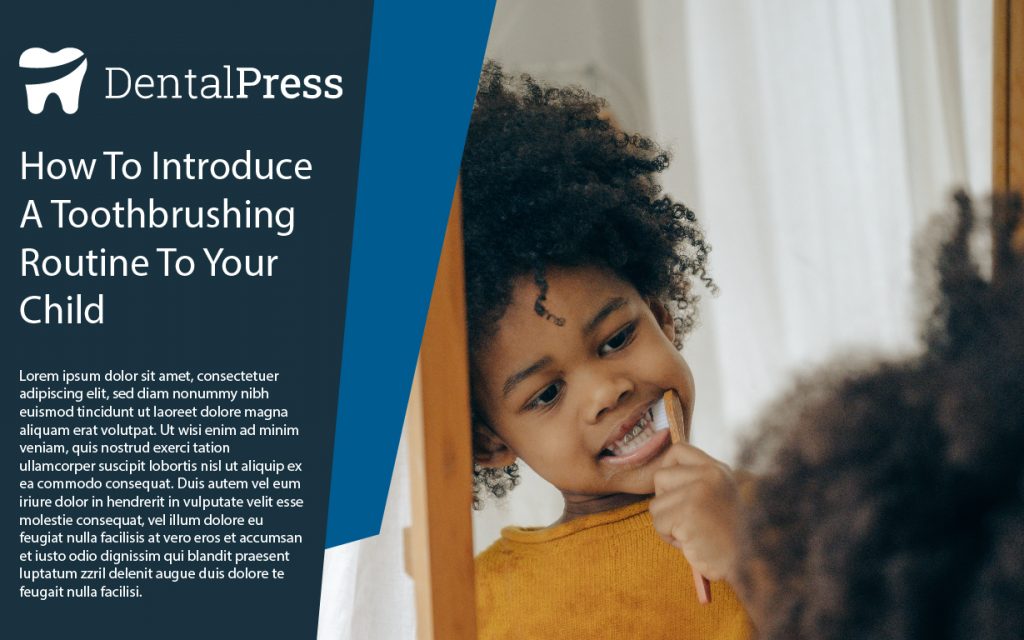How To Introduce A Toothbrushing Routine To Your Child
10 January 2022
Posted by zhou
5 minute read

It’s the epic battle between parent and child – getting your little one to brush their teeth. You have all the best intentions, having bought them a cute little toothbrush, early years toothpaste and a stool for them to stand over the sink. However, when the time comes to start brushing, your child starts having a meltdown.
Unfortunately, since toothbrushing is recommended twice daily, you’re having to manage this ordeal in the morning and at night – every. single. day. Before you know it, morning and evening toothbrushing routines start to fall by the wayside and you begin to dread doing it. What is a parent to do?
I recommend a two-phased approach to introduce toothbrushing to children, beginning at a very young age. This way, when it comes time to begin your twice-daily toothbrushing routine, they’re already exposed to the tool and the routine.
Phase One- Pre teeth
When my son was just an infant, I bought him a very small, soft toothbrush before it was even needed. It was something he could hold onto and play with. I didn’t put toothpaste on it at first, but it had a teething ring at one end so he could chew on it. It was exposure to a brush at an early age.
During every bath time and when I got him ready in the morning, I gave him the toothbrush to hold and play with. This helped establish a routine so that by the time we were ready to start brushing his teeth he was comfortable and familiar with the fact that twice a day he had to have contact with a toothbrush.
Phase Two- Once teeth have started to erupt
The second step in my approach to introducing a toothbrushing routine to your child is adding toothpaste to the brush. Be sure to choose a lower fluoride early years toothpaste and add the tiniest smear to the brush. Just a smear is enough to add fluoride to their routine but limit the amount they may ingest.
When brushing be sure that you, the parent, actually does it with them in order to control the cleaning and ensure it’s done properly and thoroughly. To enable this though a good technique is to let them first brush without toothpaste, and then I would brush them after with the smear of toothpaste. To make it more fun for your child, I recommend asking them to brush your teeth with an adult manual toothbrush and then you brush theirs with their toothbrush. Oral B have an app for a smart device that has tooth brushing games and a timer to make sure your child is brushing for the adequate time.
Make it fun and start early
Toothbrushing time is not always a quick process – you have to make it fun and not laborious. It should be done twice daily in a non-stressful environment. As soon as the task seems pushed on a child, their instinct is to say no and that’s when your battle begins. If you introduce a toothbrush all of sudden out of the blue one day then it is out of a routine for them and they may challenge it.
I often find parents who start to establish a toothbrushing routine when the child is a little older struggle the most. Once teething is established, the gums may be tender therefore introducing it at that time may be difficult especially when a child is old enough to put barriers up. Parents who introduce a toothbrush routine earlier than necessary often find they are subject to less resistance.
How to brush a child’s teeth
I used to sit behind my son to brush his teeth. Being a dental hygienist, this mimicked how I treat my patients, so I found it easier. Other parents may find sitting in front of their child easiest. Whatever works for you is fine, so long as your child lets you do it.
You should brush for one to two minutes for small children and get them to spit but not rinse. Rinsing washes away the fluoride that is used in toothpaste to make the teeth strong and prevent tooth decay.
Visit the dentist often
It’s also a good idea to visit a hygienist regularly to get some tips on how to best brush and look after your child’s teeth to prevent decay. If you’re not scared of the dentist yourself, then take your children with you to your dental exams to expose them to the dental clinic setting. Yorkshire Dental Suite is the perfect place for this as it is a relaxing and calm environment, which will keep you and your little one calm and relaxed. However, if you do have a phobia of dental treatment it’s not a good idea to bring them along as they may sense your fear.
A lot of parents ask me when they should start bringing their child for their first dental exam. The answer is when they are aged 1.
If you do come and see us here at the Yorkshire Dental Suite, make sure you book your child in for regular appointments with Claire, our hygienist from the age of 2. This ensures they adopt great techniques and healthy routines from an early age. And when you come for you appointments, try to not show them any fear or emotion you may be suffering; your own fear of the dental practice is not good for children as it rubs off on them and instills fear as they age.
